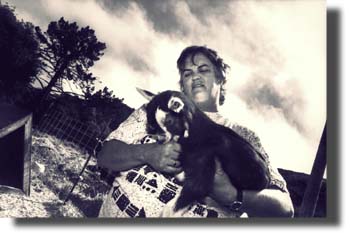Collective Concern
Butting Heads: Charged with multiple counts of animal cruelty, goat breeder Fran Simmons says that animal welfare agencies do not understand agrarian life.
When kindly eccentrics who feed hundreds of 'pets' and the humane society square off, the animal 'victims' often get loved to death
By Kelly Luker
EACH DAY, LYNN AND JEFF Killitz passed a herd of penned goats that faced the road as the couple made their way towards the coast north of Santa Cruz. The smell was bad and getting worse, but what concerned the couple was how many animals were crowded into such a small area, and as Lynn put it, "they kept getting more and more per square foot."
Finally, Jeff called San Mateo County's Peninsula Humane Society, which went out to investigate. According to its report, more than 300 goats were crowded into about an acre-sized swamp of mud, urine and feces. Some animals had been mudcaked so long that they had difficulty walking, and hair fell off with the mud in large chunks, leaving raw flesh. Most pens were without water, and what water there was had become a breeding ground for mosquitoes.
Untrimmed hooves curled up and around as much as five inches, nearly crippling the animals. Incorrectly removed horns, called scurs, had regrown and, in one case, doubled over, puncturing the skull. Most had upper respiratory infections, the result of overcrowding.
When humane officers returned to the home of Maryella Woodman, Frances Simmons and David Williams the following day, they seized more than 200 goats and charged the three with 242 counts of animal cruelty and neglect. More than mere hobbyists, the three were known nationally on the dairy show circuit, and had animals that were valued in the thousands of dollars.
Although this situation unfolded locally, it is joined by hundreds of similar cases involving dogs, cats, rabbits and every other imaginable animal throughout the country. For Williams, Woodman and Simmons fit what prosecuting District Attorney Irene Holmes calls "the classic collector profile": people who literally love animals to death.
For these people, one pet is too many and a thousand is not enough as they obsessively collect more animals than they can possibly care for. Their tales are depressingly familiar to every animal control agency and have inspired articles, psychological studies and, of course, horror legends within the animal welfare world. Animal control agencies tell stories about the woman who kept 50 dogs in an 8-by-10 foot trailer, about the man whose house was filled with hundreds of sick and dying dogs, including dozens of carcasses stacked neatly in the closet, about places so overrun with animals and waste that officers needed gas masks to enter.
Protection officers also will tell you that virtually every run-in with animal collectors creates a storm of controversy, just as the Pescadero situation has. It invariably pushes one of society's most volatile hot buttons--animals and our relationship with them.
Most communities claim at least one "cat lady," a kindly old woman who sacrifices her pension to feed hundreds of stray and feral cats. As far as animal welfare groups are concerned, there is nothing kindly about it, especially for the animals. In fact, it is a sentence of slow and painful death to feed these animals without providing medical care, vaccinations, spaying and neutering. Collectors also confuse preservation of life with reverence for life, according to those who have studied them.
"Sometimes people think that saving these animals, at any cost, is better than having them dead," says Kat Brown, director of operations at the Santa Cruz County SPCA. Brown is joined in that observation by Pamela Frasch, an attorney with the anti-cruelty division of the Animal Legal Defense Fund, a Portland-based animal welfare organization. She has prosecuted about half a dozen animal-collector cases and recalls one collector who, when her dogs were seized, fought to keep them from being treated with medication for heartworm. Demanding holistic treatment, the woman kept the case tied up in court as each of the dogs died a painful death from that illness.
"The standard line," says Frasch, "is, 'I love these animals and no one can love them as I can.'" She has identified what appears to exist at the eye of this storm--almost literal blind love.
In animal abuse cases, public agencies often must choose
Not Kidding Around
THE RAMSHACKLE HOUSE is about a half mile outside the quaint seaside town of Pescadero. Dave Williams answers the door, ready to turn me away until I mention the name of another goat breeder we know in common. It is the story of the goats that brings me here today, because it is a story that makes no sense. With my four Nubians and Alpines, I thought I understood a little about this small but dedicated subculture of goat owners.
Clearly I was wrong, because it makes no sense that people with championship dairy goats would also neglect them. It makes no sense that their peers would turn criticism and rage towards the rescuing agency rather than towards those who have appeared to put the animals in harm's way.
Williams, joined by Fran Simmons, ushers me past a cat litter-box filled to overflowing and through a cluttered house to the living room. A half-dozen newborn goat kids bleat from their home in a couple of boxes near the kitchen. A few large pots of milk sit on a filthy stove, awaiting pasteurization. Cats and kittens wander throughout the house, and the ammonia from the scent of cat urine is so strong it burns the lungs. In a stunning understatement, Simmons casually admits, "I wouldn't win housekeeper of the year award."
In her fifties, with striking green eyes that often fill with tears, Simmons does most of the talking today. Asked about her proclivity for so many animals she responds, "You're not gonna start with that 'collector' bullshit, are you?"
And, in many ways, this trio falls far from the stereotype of elderly recluses. Simmons is an attorney who works in computer business sales and her friend Maryella Woodman is a registered nurse at a nearby hospital. Williams, who has been staying with the two for the past couple of years, works at a flower shop in San Francisco. Simmons knows they are trying to pin the collector label on her and she ticks off a list of reasons why that doesn't fit.
Breeders need this many animals to develop championship strains. If people think this is overcrowding, "they should check out the average dairy," she says. As far as Simmons is concerned, the only problem is the SPCA which, Simmons asserts, "think that no one should breed animals. There's a concerted effort to put animal breeders out of business." The three goat owners and their supporters are convinced that this seizure was merely grandstanding on the part of the Humane Society, a flashy attempt to gain publicity, sympathy and donations.
Simmons adamantly denies any neglect of her animals and points to hundreds of show ribbons strewn across the book cases, demanding "Do you think judges would award me those if I had out-of-shape animals?" If there was any problem at all, it was merely cosmetic, she says. The rains were bad this year, bringing nonstop mud and muck, but that was true for all the livestock people. Asked about the overgrown hooves, Williams says he never trims in the winter, and besides, "They can still walk, can't they?"
What further complicates the case is there are two separate herds, one belonging to the two women, the other belonging to Williams. Privately, Simmons allows that if there were any problems, it was with Williams' goats, which had been allowed to mingle with hers. As we walk among the now-clean pens where her remaining goats are housed, she stops periodically to offer anecdotes about her various "girls," each of which she addresses by name. She talks of heroic and expensive surgery for one, the odd habits of another. She says that this has been one more nightmare in a life that was none too easy to begin with. She has battled depression for years and has recently turned over her rifle to a friend for safekeeping.
"Why didn't they give me notice first?" Simmons asks. Because of that, she is convinced, the goats are worse off now in the Humane Society's care and offers pictures taken by her veterinarian as proof. One photo shows a brutally inflamed udder that is long overdue for milking. Another portrays a dead kid lying unnoticed in the pasture. "They are systematically trying to kill my goats," she says, and begins to cry again.
Pet Peeved: San Mateo assistant District Attorney Irene Holmes will be prosecuting the Pescadero goat owners accused of animal cruelty. She notes of animal collectors, "They fight hard."
Denials and Deaths
IRENE HOLMES SITS at a conference table in the Redwood City District Attorney's office. Holmes, the Deputy DA prosecuting this case, holds photographs taken at the time of seizure that she begins dealing out like a stack of cards, each one documenting the state's case against Williams, Woodman and Simmons more indelibly. Because of her expertise in animal cruelty cases, she often is called by other counties for advice on prosecution.
What never changes with animal collectors, she explains, is their deathgrip on denial. Holmes gives an example of a woman who was shown a picture of one of her dogs that was seized. The photo showed a Weimeraner so starved that it was literally shedding its intestines and rectum. It died within hours after the photo was taken. Holmes remembers that the woman looked at the picture and finally commented, "I guess it did seem a little ill."
Holmes also passes on a stack of information about animal collectors amassed from various animal welfare agencies throughout the country. A fact sheet on top, distributed by the New York Humane Society lists several traits common to "animal addicts": persecution complex; neglect of personal, physical and environmental conditions; presence of enablers (people who help continue the addiction); alibis for behavior; and a shrewd ability to attract sympathy.
This being the age of psychology, the professionals have also tried on various pathology templates for these folks, trying to find a one-size-fits-all. Some argue for the addiction model, likening it to chemical dependency. Others believe animal collecting to be more typical of obsessive/compulsive disorders. They all agree on one thing--collectors rarely, if ever, recover.
"Collectors are hard to reason with and they fight hard," Holmes notes. She laughs at the contention that the Humane Society did this for donations. "It's cost $80,000 so far. We've well surpassed the value of the goats at this point." Donations couldn't hope to cover but a small fraction of that. Given the hit its budget has taken, ostensibly lessening the resources for other animals in need, why didn't the goat breeders get a second chance?
"The Penal Code says they have to take any animal that needs immediate attention," explains Holmes, adding that the extreme overcrowding, lack of water and the presence of upper respiratory infection made seizure inevitable and immediate.
Holmes is not surprised at the controversy surrounding this case. "Animal cruelty is such an emotionally charged issue," she says. That being the case, it can pretty well be guessed that the local contracting agency for animal control will be the lightning rod.
Many in the livestock industry believe that organizations like the SPCA or the Humane Society are run by touchy-feely animal lovers who do not understand the demands of agrarian life. In some ways, they may be right. David Casper is a veterinarian with UCSC's Long Marine Lab, whose work with dolphins also has put him at loggerheads with animal activists. He explains, "We're witnessing the first generation that has virtually no experience of animals in a utilitarian sense."
Those familiar with the Pescadero goat owners, including their animals' veterinarian, Susan MacInness, tend to agree. "I will grant the place is not aesthetically pleasing to the general public," she says, "but [an aesthetically pleasing atmosphere] is not the way goats are kept." MacInness insists the goats were well-fed and free of all but cosmetic problems. She notes that agency officials came to her clinic only after the animals were confiscated, frantically trying to find temporary homes for them. She believes neither the Humane Society nor its volunteers were trained to deal with the specialized needs of ruminants, a livestock classification that includes goats, sheep and cows.
MacInness' views are supported by Santa Cruz resident Jodi Frediani, who does freelance photography for the SPCA and is also an animal trainer who has raised goats for more than 20 years. Frediani, who was volunteering her services at the Marin Humane Society when several of the goats arrived for temporary shelter, was "appalled" at how the animals were treated by volunteers and staff. They did not know how to milk and, when Frediani offered her assistance, the "specialists" turned her down. "There tends to be an attitude--'We know it all and we don't want anybody's advice,'" Frediani notes.
The staff at the Peninsula Humane Society denies that the agency was ill-prepared for the seizure. "We had three ranches prepped to take them. And, we have people we work with on a regular basis," says Leslie Walker, the organization's public information officer. Yet Walker cannot explain why feed donations and help from friends of the goat owners have been rejected.
Just as the livestock industry has circled its wagons, perhaps the animal welfare agencies have developed a bunker mentality from working in the trenches of controversy, unable to separate help from hindrance.
On Burro'd Time: Santa Cruz SPCA Director of Operations Kat Brown has worked with dozens of animal collectors and has witnessed horrific cases of neglect.
After working for more than a decade at the SPCA, Kat Brown says she has gotten it all, through hate letters, anonymous phone calls or people shouting at her over the counter. "I've heard, 'You're just a bunch of dykes who hate men,' or 'You're animal rights activists who want to outlaw people from ever owning animals.' Look, we're talking about animal welfare, not animal rights," she says, with some exasperation.
Since our first conversation, Simmons sends faxes--sometimes as many as three a day--of her thoughts, concerns and any clues that may help people understand this situation. Mostly, though, she says she is worried about her animals, convinced that they will all die without her care.
Although that is unlikely, there is enough evidence that Simmons may have reason to be concerned. Yet the Peninsula Humane Society does not appear to acknowledge her--what they hear instead, most likely, is that characteristic observed by Animal Legal Defense Fund attorney Frasch about collectors: Nobody can love my animals like I can.
Simmons' bulletproof denial is equally frustrating. Asked if she thought the animals' confiscation was a case of moving from the frying pan into the fire, she becomes extremely agitated at the analogy. Why can't I understand? she asks. There were no, absolutely no, problems to begin with.
Both sides have moved out of hearing range from each other, rigid and polarized by their assumptions. Simmons, Williams and Woodman have been neatly wedged into a clinical diagnosis while the Peninsula Humane Society has been cast as wild-eyed "humaniacs" intent on depriving people of their civil rights, by the other.
Although spokespersons for both views insist they alone know how to properly care for these animals, both camps appear to have fallen short of their duties, revealing the real tragedy that lurks beneath the rhetoric.
As the trial gets underway next month in Redwood City, the final assessment will belong to the jury.
This page was designed and created by the Boulevards team.

Robert Scheer![[line]](/gifs/line.gif)
between the welfare of the elderly and their pets.![[line]](/gifs/line.gif)

Robert Scheer
Robert Scheer
From the Dec. 26, 1996 to Jan. 1, 1997 issue of Metro Santa Cruz
Copyright © 1996 Metro Publishing, Inc.
![[MetroActive News&Issues]](/gifs/news468.gif)